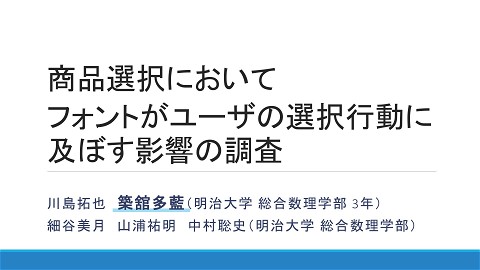DoReMi Steering Wheel: A Driving Assist System with Sound Display Depending on the Rotation Angle of the Steering Wheel
1.2K Views
September 07, 22
スライド概要
明治大学 総合数理学部 先端メディアサイエンス学科 中村聡史研究室
関連スライド
各ページのテキスト
DoReMi Steering Wheel A Driving Assist System with Sound Display Depending on the Rotation Angle of the Steering Wheel Sayuri Matsuda Yuki Nakagawa, Yukina Funazaki, Naoto Matsuyama, Satoshi Nakamura, Takanori Komatsu (Meiji University), Takeshi Torii, Ryuichi Sumikawa, Hideyuki Takao (SUBARU Corp.) 0
Let's see how to drive a curve 1
Let's see how to drive a curve 2
Let's see how a novice driver drives 3
Proposed method: “DoReMi Steering Wheel” ♪ ♪ 4
Proposal 5
Background: curve is difficult for novice drivers ! The information from visual and arm sensation suggests how far to turn the steering wheel. Needs experience → might be afraid to drive before they get used to it. 6
From our survey what’s your weak point while driving? 400 350 334 300 250 199 200 179 213 150 100 50 0 Steering wheel Operation Brake Accelerator Etc A Web survey of 2,000 drivers using Yahoo! Crowdsourcing 334/632(23%) : not good at driving 7 52% of them : steering wheel operation was difficult
Background: what’s your weak point while driving? 400 350 334 300 250 199 200 179 213 150 100 50 0 Steering wheel Operation Brake Accelerator Etc A Web survey of 2,000 drivers using Yahoo! Crowdsourcing People are not good at who driving oftenthat have 334 out ofwho 632 respondents (52%) reported they problems with steering. have difficulty while driving selected steering wheel operation. 8
Purpose To help novice drivers master driving a curve easily 9
Support Methods using visual information Visual information is always important while driving. Too much visual information is dangerous. 10
Support Methods using auditory information • • Audio prompts can support the overall performance of visual tasks better than visual prompts. [Parush et al., 2005] Driving skills improved without increasing the load by a system that provides feedback of the car's position based on the difference in sound pressure between the two ears. [Onimaru et al., 2008] Support from auditory information is appropriate while driving. 11
Support Methods using auditory information The shape of a graph is represented by a musical scale for blind person. [Lorna et al., 2003] Feedback of steering angle using a musical scale 12
Proposed method: “DoReMi Steering Wheel” ♪ ♪ Plays sine waves of a musical scale depending on the steering angle. →The driver can know the steering angle without looking at the steering wheel. 13
Demonstration; Doremi Steering wheel 14
Not good driver 15
Experiment • Used a driving simulator which implements "DoReMi Steering Wheel" • The number of participants was 26. • Comparison was made between with and without "DoReMi Steering Wheel". 16
Experimental Procedures 20 consecutive trials on each type of curve. 17
Hypothesis The number of steering corrections per trial would decrease more when drivers use the “DoReMi Steering Wheel” than when they do not use it. Steering corrections The increase or decrease of the amount of steering wheel operation. Not suitable for driving and will make the ride uncomfortable. 18
Results: the average number of steering corrections Over-all length All participants Infrequent drivers Frequent drivers ー Standard steering wheel ー DoReMi Steering Wheel 19
Results: the average number Doremi group corrections GOOD results of steering Standard group BAD results Over-all length All participants Infrequent drivers Frequent drivers ー Standard steering wheel ー DoReMi Steering Wheel 20
Results: the average number of steering corrections During the curves All participants Infrequent drivers Frequent drivers ー Standard steering wheel ー DoReMi Steering Wheel 21
Results: the average number Especially infrequent drivers corrections of steering Doremi group GOOD results Standard BAD results During the curves group All participants Infrequent drivers Frequent drivers ー Standard steering wheel ー DoReMi Steering Wheel 22
Results: Questionnaire on ease of turning curves Significant difference in the ease of driving curves between using the DoReMi Steering Wheel and standard Evaluation of ease of turning curves (5-point scale) 5 ∗ 4.5 4 3.5 3 2.5 2 1.5 1 DoReMi Standard 23
Comments “I found a reference for the scale and tried to turn the steering wheel so that it would reach that scale.” “I was conscious of keeping the rhythm of the scale change constant from trial to trial.” My attention was more on matching the pitch than on driving.” 24
Benefits of DoReMi Steering Wheel ① Without looking at the steering wheel Can know how much we are turning the steering wheel at the moment. Can know the amount of rotation until the steering wheel is fully turned. 25
Benefits of DoReMi Steering Wheel ② Will be able to recognize a curve on a scale of how far we need to turn the steering wheel. Let's turn to F! 26
Benefits of DoReMi Steering Wheel ② 27
Discussion of steering corrections No significant difference in the number of steering corrections between using the DoReMi Steering Wheel or not. Reason ・Not become familiar with the DoReMi Steering Wheel ・Became fatigued 28
Discussion: Questionnaire Results Possible that it was difficult to focus on the driving action due to concentrating on the sound when using the DoReMi Steering Wheel. Designing sounds that do not disturb concentration 29
Challenges / Future work Use of the DoReMi Steering Wheel tended to decrease the number of steering corrections, especially for infrequent drivers. However, there was no significant difference. re-design the experiment (variety of curves) 30
Summary Purpose Proposed method Help novice drivers to master navigating curves easily “DoReMi Steering Wheel” Results Use of the DoReMi Steering Wheel tended to decrease the number of steering corrections, especially for infrequent drivers. 31





